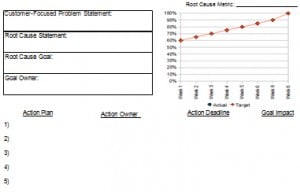 Strategic customer experience results require a strategic approach in the way we collect data and in the way we take action on it. Of all the strategies within a company, what has the potential to be more far-reaching and impactful than how we understand our funders (customers) and how we cater to their propensity to continue funding us? What may come to mind is an acquisition or merger or reorganization or new product. But even so, these same funders are in-play in each of these scenarios. There’s really no way to separate customers, as our ultimate funders, from any other business strategy.
Strategic customer experience results require a strategic approach in the way we collect data and in the way we take action on it. Of all the strategies within a company, what has the potential to be more far-reaching and impactful than how we understand our funders (customers) and how we cater to their propensity to continue funding us? What may come to mind is an acquisition or merger or reorganization or new product. But even so, these same funders are in-play in each of these scenarios. There’s really no way to separate customers, as our ultimate funders, from any other business strategy.
This acknowledgement may shine a new light on what we really should be doing in customer experience management (CXM). In her presentation at last month’s CXPA conference, Erin Wallace of John Deere pointed out that every major undertaking in a company — like new product development, capital investment, market expansion, deployment of a major technology (e.g. ERP), etc. — requires carefully thought-out plans and decisions. Using a tractor as a metaphor, she described the requirements for best-in-class CXM. The windshield represents CXM vision and strategy. The steering wheel represents the CXM organization and governance. The wheels represent CXM processes and tools. And the engine represents CXM measurement.
 Let’s talk about those wheels. Robust processes and tools are necessary for strategic action on VoC data. When I was at Applied Materials we had a well-oiled machine in our VoC actioning. First, we researched what it takes to drive action, by talking to action experts outside and inside our company. We identified tools, including a CX improvement facilitator in each business unit (usually from the Quality organization), how to prioritize CX action areas, how to digest customers’ verbatim comments during an action planning workshop with cross-functional teams, how to identify themes and root causes of the comments, how to create specificity in the action plans and sanity-test that they address the root causes, and how to create progress metrics for action plans.
Let’s talk about those wheels. Robust processes and tools are necessary for strategic action on VoC data. When I was at Applied Materials we had a well-oiled machine in our VoC actioning. First, we researched what it takes to drive action, by talking to action experts outside and inside our company. We identified tools, including a CX improvement facilitator in each business unit (usually from the Quality organization), how to prioritize CX action areas, how to digest customers’ verbatim comments during an action planning workshop with cross-functional teams, how to identify themes and root causes of the comments, how to create specificity in the action plans and sanity-test that they address the root causes, and how to create progress metrics for action plans.
 Let’s talk about that windshield. We created a diagram to show the steps and explain how to make changes that customers would reward. We noted things about our culture that could accelerate or hinder adoption, and we created processes and tools to address both sides of that coin. Then we shopped our plan with the C-team. They stewed over our survey results for quite a while, and, facilitated by our VP-CX, they eventually agreed on a company-wide approach to interpreting, acting on, and being accountable for progress, resolution, and prevention of issue recurrence. We worked with people in HR, Marketing, and IT whose help we needed to pull together these tools and processes.
Let’s talk about that windshield. We created a diagram to show the steps and explain how to make changes that customers would reward. We noted things about our culture that could accelerate or hinder adoption, and we created processes and tools to address both sides of that coin. Then we shopped our plan with the C-team. They stewed over our survey results for quite a while, and, facilitated by our VP-CX, they eventually agreed on a company-wide approach to interpreting, acting on, and being accountable for progress, resolution, and prevention of issue recurrence. We worked with people in HR, Marketing, and IT whose help we needed to pull together these tools and processes.
Let’s talk about that engine. In our measurement of customer perceptions, we gave every business unit, account team, and support function their own report — their own cut of the data, to minimize finger-pointing and maximize ownership, or CX adoption and accountability. To identify patterns we studied cross-tabulations, conducted correlation analyses, characterized groups of customers who saw things similarly, linked various customer feedback sources, connected quantitative (ratings) and qualitative (verbatim) data, and explored linkages between customer perceptions, sentiment, behaviors, operational data, employee opinions, and financial data. Patterns were enriched through root cause analysis (ask “why?” 5 times), Pareto charts, scatter diagrams in quadrant charts, and estimating customer lifetime value. Patterns were helpful in motivating collaboration across organizations that had the same top priority.
In our measurement of VoC progress, we published (internally, updated quarterly) customer survey trends as a context, and what we called six-up charts (six graphs on a page) or flag charts (all organizations’ graphs for a given priority area in a single row for each area, with flags indicating upward, downward, or static trends). Our emphasis was on how various organizations might learn from one another, and how well we were moving the needle internally as a preview of what customers would soon experience. Eventually, we could overlay VoC trends and financial trends on top of our internal progress metrics. Our philosophy was that what we did inside the company would eventually be what customers saw and reported in surveys, and that would eventually be reflected in our revenue, costs, and growth. Our C-team received bound copies of these progress report books at the same time that they received similar financial reports in preparation for their quarterly call with industry analysts.
Let’s talk about that steering wheel. Our organization was in Corporate Quality because our executives wanted to see real change, and that was the place with the most tools to do that. I had a market research expert on my team, along with a quality metrics analyst and three CX improvement facilitators for Europe, Asia, and Americas. The product lines and support functions were divvied up among them. Across the company we liaisoned with a counterpart in the Quality function of their parent business unit. We did all we could to empower them with moral support and skills in change management, quality tools (i.e. Lean/Six Sigma), CX management (i.e. the six CCXP competencies), organizational learning, process improvement, etc.
Just after we conducted the round-the-globe action planning workshops we published the top themes from our latest relationship survey and promised customers we’d report back to them in nine months. And we did. At the end of the fiscal year the VP-CX and I met with each GM throughout the company to discuss their action plan progress and determine their bonus multiplier accordingly.
We didn’t stop there. We saw the opportunity for further strategic action. This involved timing the survey reporting to coincide with strategic planning processes, and making VoC analyses available specific to big initiatives and decisions. We continued to create alliances with many people across the company, to weave-in CX insights across our ecosystem: employee communications, recognition, hiring, onboarding, performance reviews, staff meeting agendas, training, leadership development, supplier management, day-to-day work, and so forth. We tied external VoC to internal CX management, to drive improvements in timely and effective hand-offs across the company.
From the start, everyone understood this whole process and we repeated it year after year. We constantly welcomed ideas from our stakeholders and involved them in refining our whole methodology as our collective maturity increased. It wasn’t always easy, but it was very gratifying to feel company-wide momentum.
In B2B CXM it’s especially important to align the entire company in seeing their ripple effects on customers’ well-being. Employees have an innate desire to help customers love the company. If we establish processes and tools that integrate CXM into their ongoing routines, they’ll engage in strategic action that customers will reward.




Completely agree with the theme of this blog. In many important respects, B2B customer decision-making is driven by similar emotions and memories as are created in B2C customer experience. Employees and processes are critical here. As such, it is a useful goal to see advocacy as a fully monetizing result of B2B CX: http://beyondphilosophy.com/business-business-customer-advocacy-real-possibility-real-oxymoron/
Thanks for your comment, Michael. What I’m trying to convey in this article is the need to get well beyond the prevailing efforts toward customer advocacy (word-of-mouth) to making substantial changes happen all throughout the company.
As I listen to the woes of B2B CXers I can see that they’re still trying to shortcut the actioning that is really necessary to earn advocacy organically. When customers feel and see alignment of the company per their advice they naturally want to advocate.
Our CX industry for the past 10-15 years has been advocating too many short cuts, in my opinion, when in reality it does require company-wide alignment with customers to see significant — and enduring — gains in business results.
Lynn –
Let me correct you on one point. Advocacy is not merely (informal offline and online) word-of-mouth. It also actively brings into play brand favorability, consideration set, and purchase experiences: http://customerthink.com/is-there-a-single-most-actionable-contemporary-and-real-world-metric-for-managing-optimizing-and-leveraging-customer-experience-and-behavior/ And, we agree that building stakeholder trust and value is an enterprise-wide strategic priority: http://customerthink.com/building_trust_its_a_matter_of_fairness_confidence_authenticity_openness_sincerity_and_exceedin/
Michael